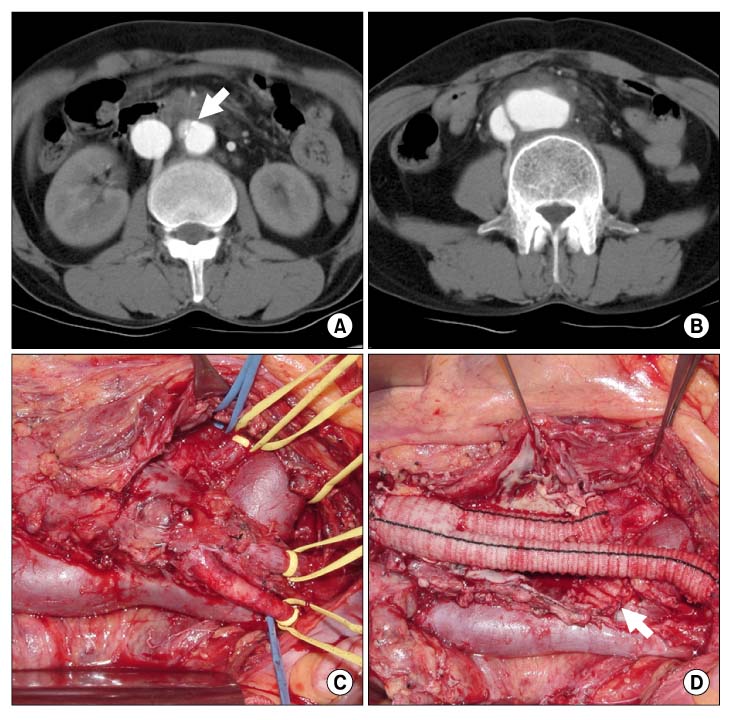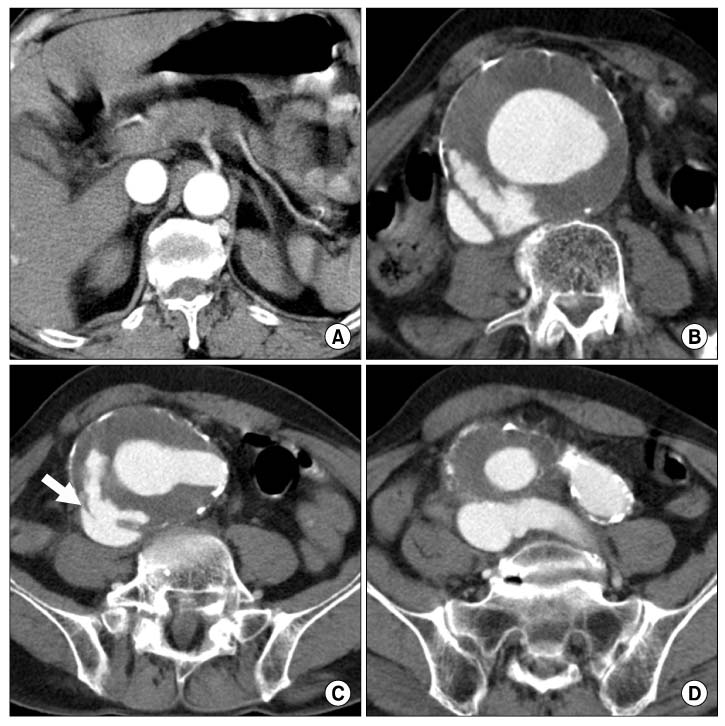J Korean Surg Soc.
2009 Jan;76(1):66-71. 10.4174/jkss.2009.76.1.66.
Primary Aortocaval Fistua Associated with Abdominal Aortic Aneurysm
- Affiliations
-
- 1Division of Transplantation and Vascular Surgery, Department of Surgery, Kyungpook National University School of Medicine, Daegu, Korea. shuh@mail.knu.ac.kr
- KMID: 2040608
- DOI: http://doi.org/10.4174/jkss.2009.76.1.66
Abstract
- Primary aortocaval fistula (ACF) is a rare complication of abdominal aortic aneurysm (AAA), occurring in only 4% of ruptured cases and less than 1% of all AAAs. The hemodynamic changes resulting from the major shunt caused by the ACF include a sudden increase in inferior vena caval pressure and volume with renal venous hypertension and a decrease in total peripheral resistance. So, if untreated, it leads to irreversible high output heart failure. Preoperative diagnosis is crucial, as adequate preparation should be made for massive bleeding expected at operation. Successful treatment depends on management of perioperative hemodynamics, control of bleeding from fistula and prevention of thromboembolism. We report two cases of successfully treated spontaneous ACF with a review of the literature.
MeSH Terms
Figure
Reference
-
1. Cooley DA. Resection of ruptured aneurysms of the abdominal aorta. Discussion of David M, Dyes WS, Grave IS, et al. Ann Surg. 1955. 142:623.2. Brewster DC, Cambria RP, Moncure AC, Darling RC, LaMuraglia GM, Geller SC, et al. Aortocaval and iliac arteriovenous fistulas: recognition and treatment. J Vasc Surg. 1991. 13:253–265.3. Javid H, Dye WS, Grove WJ, Julian OC. Resection of ruptured aneurysms of the abdominal aorta. Ann Surg. 1955. 142:613–621.4. Bednarkiewicz M, Pretre R, Kalangos A, Khatchatourian G, Bruschweiler I, Faidutti B. Aortocaval fistula associated with abdominal aortic aneurysm: a diagnostic challenge. Ann Vasc Surg. 1997. 11:464–466.5. Callogaro KD, Savarese RP, DeLaurentis DA. Unusual aspects of aortovenous fistulas associated with ruptured abdominal aortic aneurysms. J Vasc Surg. 1990. 12:586–590.6. Gilling-Smith GL, Mansfield AO. Spontaneous abdominal arteriovenous fistulae: report of eight cases and review of the literature. Br J Surg. 1991. 78:421–425.7. Coulier B, Tilquin O, Etienne PY. Multidetector row CT diagnosis of aortocaval fistula complicating aortic aneurysm: a case report. Emerg Radiol. 2004. 11:100–103.8. Maeda H, Umezawa H, Goshima M, Hattori T, Nakamura T, Nishii T, et al. Surgery for ruptured abdominal aortic aneurysm with an aortocaval and iliac vein fistula. Surg Today. 2007. 37:445–448.9. Lay JP, Swainson CJ, Sukumar SA. Paradoxical pulmonary embolism secondary to aortocaval fistula: diagnosis by helical CT. Br J Radiol. 1999. 72:507–509.10. Vetrhus M, McWilliams R, Tan CK, Brennan J, Gilling-Smith G, Harris PL. Endovascular repair of abdominal aortic aneurysms with aortocaval fistula. Eur J Vasc Endovasc Surg. 2005. 30:640–643.
- Full Text Links
- Actions
-
Cited
- CITED
-
- Close
- Share
- Similar articles
-
- Aortocaval Fistula Complicating Abdominal Aortic Aneurysm: A Case Report
- Type A Aortic Dissection with Aortocaval Fistula: Report of 1 case
- Endovascular stent-graft repair of aortocaval fistula complicated by the rupture of abdominal aortic aneurysm
- Aortocaval Fistula: A case report
- General Considerations of Ruptured Abdominal Aortic Aneurysm: Ruptured Abdominal Aortic Aneurysm




